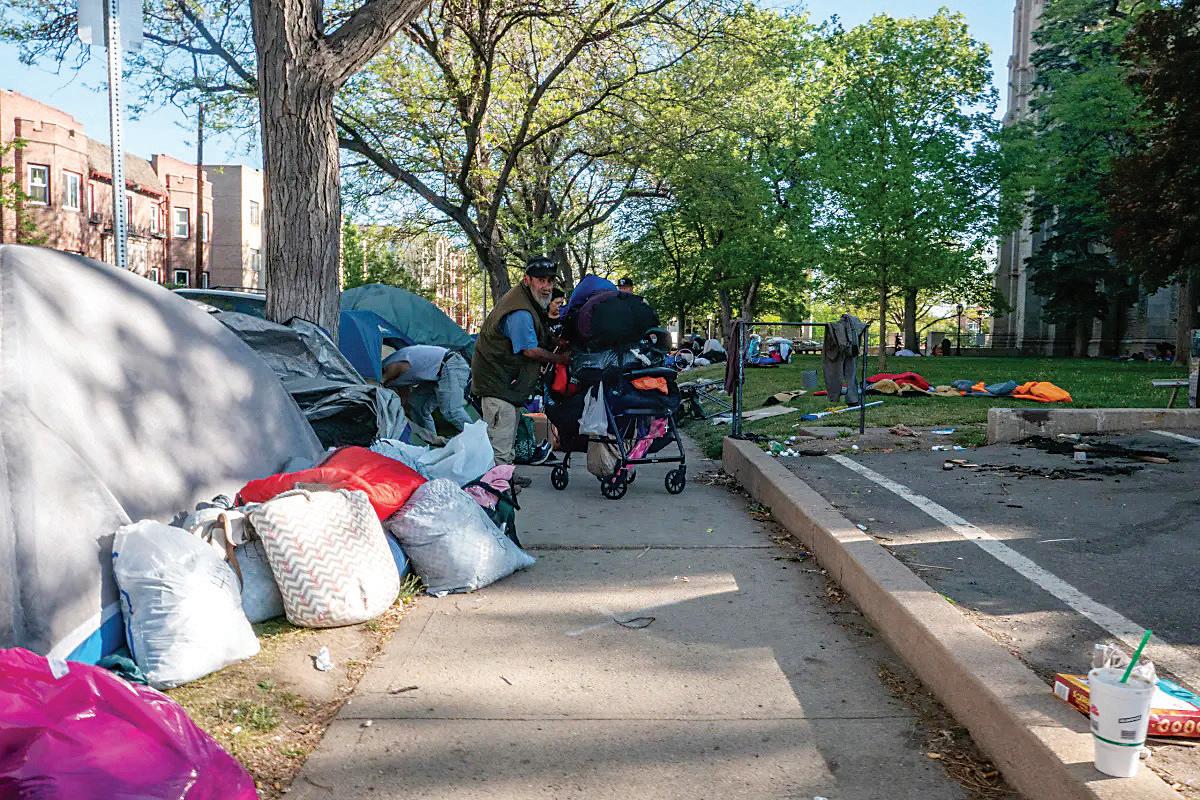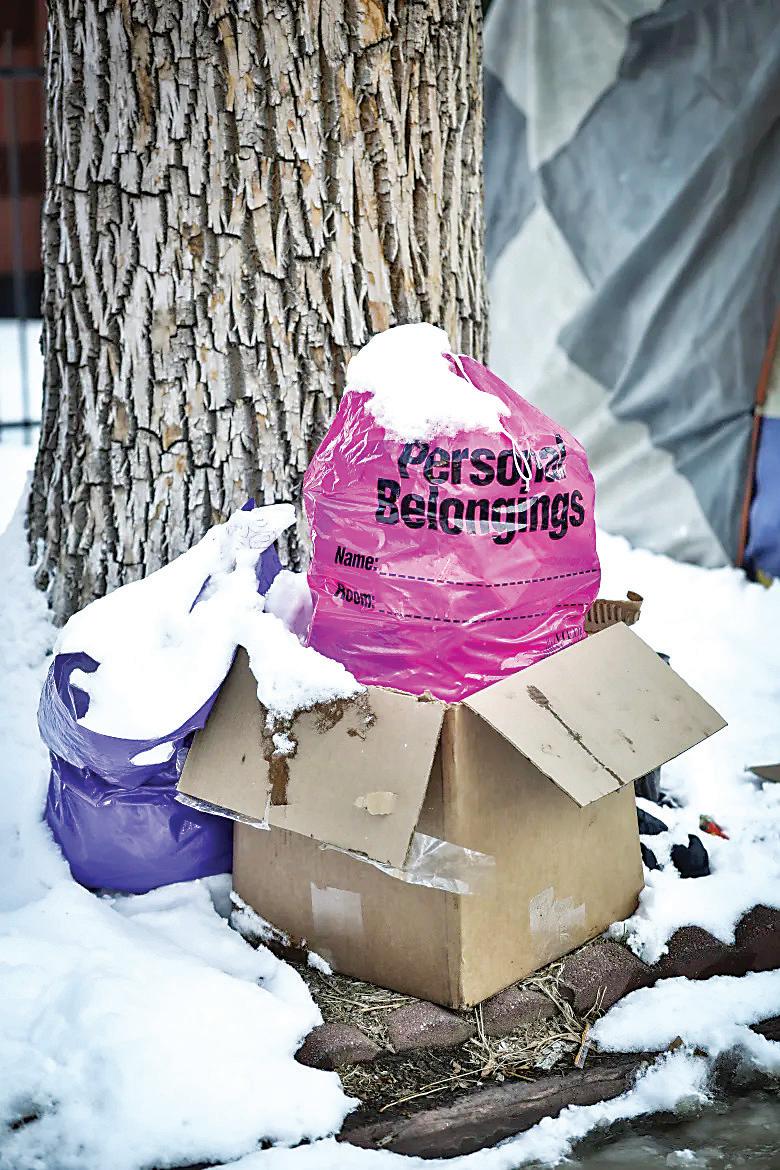
7 minute read
Chance Sports levels the playing field
New nonprofit o ers sports scholarships for low-income youth
BY BRUCE GOLDBERG SPECIAL TO COLORADO COMMUNITY MEDIA
“Equal opportunity levels the playing eld.” is is what is stated on the Chance Sports website to capture the new nonpro t’s sense of urgency about raising money so young Denver-area athletes can participate in more club sports, both locally and on the road.
BY TATIANA FLOWERS THE COLORADO SUN
e rst audit of how Denver responds to unauthorized homeless encampments found the city is mostly compliant with the law and a 2016 court case where plainti s argued taking personal property from people who are homeless without due process violated the constitution.

e Unauthorized Encampment
Response Program must work harder to ensure people who are homeless can easily get to any possessions removed from an encampment, which is especially challenging when belongings are moved to the city’s long-term storage facility at 1449 Galapago St., according to ndings of the audit, released on April 20.
Denver leaders also need to better outline and document the policies and procedures that guide the multiple agencies responsible for enforcement and outreach at encampments. For example, several departments and outreach teams don’t have nalized policies or procedures for monitoring encampments. ey also don’t have policies and procedures to track and monitor data, according to the 103-page audit. e city also is not tracking expenses related to homeless encampments or su ciently monitoring invoices and performance by contractors, which hinders their ability to ensure those workers are in fact providing agreed-upon services, according to the audit.

SEE AUDIT, P2
“... and makes it about the talent not the success,” the website continues. “ e reason a kid doesn’t make it shouldn’t be because they don’t have the opportunity.”
State Sen. James Coleman, DDenver, and former state Rep. Colin Larson, R-Je erson County, created Chance Sports in late 2022, with the goal of helping low-income families play on a club basis in basketball, football, volleyball, track and eld, cheer, eld hockey, soccer and more. ey formed the idea from when the two served together on an education committee at the state legislature. ey joined up with the Daniels Fund, which gave Chance Sports $300,000 and pledged another $200,000 to encourage matching
SEE SPORTS, P5 e Denver Mayor’s O ce did not conduct an analysis to identify the resources needed for the Unauthorized Encampment Response Program, which is made up of 10 city agencies and o ces, and so the program may not be adequately sta ed to meet its goals and responsibilities, according to the audit. is is a very vulnerable population in Denver, especially the 1,313 people, who are living on the street.” e city agreed to all 36 recommendations made by the auditor. If the city implements all recommendations by Dec. 31, Denver leaders will be better situated to ensure its encampment response program is e ectively helping vulnerable people who are homeless while maintaining transparency with Denver residents about how it spends money to respond to unauthorized encampments, according to ndings of the audit.
“ e (Raymond) Lyall settlement seems to be a driving force behind what the city is doing, and to me, that’s kind of the base level of the way this should operate, so that we’re not violating people’s civil rights,” Denver Auditor Timothy O’Brien said. “Are there plans within the response program to go above and beyond?

Laura Brudzynski, chief housing o cer and executive director for the Denver Department of Housing Stability, said adequate housing is the solution to resolving homelessness, so the city is focused on creating a ordable housing and supportive programs.
Denver has already implemented many of the recommendations in the audit report, city leaders wrote in a response to the audit’s ndings.
“Chronic unsheltered homelessness is the most complex issue any city will manage, and we appreciate the audit team, over the course of many months, taking a hard look at how our city is approaching the challenge of encampments,” Mayor Michael B. Hancock said.
“More than a housing crisis, it’s a situation made more complicated amid a nationwide drug crisis, mental health crisis and continued fallout from the pandemic on our most vulnerable residents and communities,” he said.
A rise in homelessness
Denver Homeless Initiative and many other U.S. cities and counties conduct the point-in-time count, which gathers the number of people who are homeless on one of the coldest nights during the winter.
24, 2022, showed 4,794 people were homeless that night in Denver.
Of those, 1,313, or more than 27%, were unsheltered. One in three people were homeless for the rst time and most of the population were adults older than 25. People reported physical disabilities, mental health conditions and escaping domestic violence as reasons leading to homelessness. Men and people of color are overrepresented in local homelessness. Six percent of people between 18 and 24 were homeless, according to the 2022 count.
e number of people who were unsheltered increased between 2019 and 2022 while the number of people who were sheltered remained relatively the same. Many communities, including Denver, did not conduct an unsheltered count in 2021 because of increased risk of spreading the coronavirus.
Findings from this year’s count, which only provides a snapshot of local homelessness, will most likely be nalized and published during the summer, Denver Department of Housing Stability leaders said at an audit committee presentation ursday morning.
Because the city does not track how much it spends on homeless encampments, the auditor sought to quantify e estimated total of $13.65 million outreach and cleanup costs is likely an underestimate, according to the audit.
“While it’s good to have that total, without breaking it up by actual costs per sweep or by services used speci cally for cleanups and sweeps, it doesn’t tell us much about how the city could better invest taxpayer funds on things other than camping ban enforcement,” said Cathy Alderman, chief communications and public policy o cer for the Colorado Coalition for the Homeless.
Denver’s social impact bond program showed when cities provide housing to people, they save money often spent on jails, shelters and emergency rooms because unhoused people’s needs aren’t met.
Denverites will elect a new mayor on June 6. Alderman said she hopes the city can produce more accurate data about conducting sweeps at encampments, so that the new administration can use the number to make better budgetary decisions.
Alderman said she appreciates the recommendations demanded by the audit, but is hoping for more progress toward easing homelessness in Denver.
“I’m not saying that the recommendations that were made shouldn’t be followed, because they could lead to some improvements between the city and people who are sleeping outside. But I don’t think it (the audit) provides a lot of actionable steps toward homelessness resolution and the appropriate way to deal with homelessness as a city.”
A housing crisis, opioids and the COVID-19 pandemic e a ordable housing crisis has contributed to the growth of encampments. Housing prices have nearly doubled and median rent has increased by 78% over the past decade, according to Denver’s Department of Housing Stability. e COVID-19 pandemic worsened the housing crisis, as unemployment rates quadrupled at one point and the city saw a 270% increase in requests for rent and utility assistance, according to the audit. e ongoing opioid epidemic has also complicated encampment response over the past few years, according to the mayor’s o ce. Managers in the Department of Public Health and Environment also said it can be challenging to convince some people who are homelessness to accept help. In severe cases, people may have a mental health condition, anosognosia, that keeps them from understanding they need help or that using substances is dangerous, which contributes to their resistance to accepting services, according to the audit. e city’s interaction with an encampment typically begins when outreach teams are sent to the site to help people who are homeless before a cleanup, according to the audit. e mayor’s o ce reviews complaints data twice daily. From January through June 2022, people submitted 117 nonemergency, public health complaints about an encampment at Glenarm Place and 21st Street in Five Points, and 97 complaints about an encampment at 20th Street and Chestnut Street in LoDo. e data the auditor reviewed showed the city cleaned up both sites twice during that period.
In March 2021, the mayor’s o ce and other city leaders met to discuss how to reduce the number of people who were living outdoors. Shortly after, the group created the Denver Unauthorized Encampment Response Program.

Under the program, several agencies are responsible for responding to encampments and those organizations also enforce city ordinances, conduct public health and safety assessments, connect people to human services and lead cleanups.
Most complaints about encampments come from nearby residents, Denver Department of Housing Stability leaders said ursday morning.
From Jan. 1 to June 30, 2022, Department of Public Health and Environment leaders completed 2,223 assessments, including 1,400 of encampments and 711 of recreational vehicles parked illegally.
In that same timeframe, the city completed 58 cleanups and canceled seven. Data included in the audit report also showed about 1,070 instances of personal property being stored from Jan. 1, 2019 to June 30, 2022.
Rules from the court case
In August 2016, the city was sued by local activist Raymond Lyall and others for allegedly seizing and discarding the property found at encampments without due process. e settlement agreement required the city to give at least seven days notice of large-scale cleanup unless removal is needed sooner and to provide 48-hours written notice before removing people’s personal property if the encampment does not pose a public health risk.
While the city complied with legal requirements in most instances, the audit found it did not fully comply with rules for storing and disposing of personal property, and it did not keep its property storage webpage updated. e city threw away property from its storage facility before 60 days, 2% of the time, from Jan. 1, 2019 to June 30, 2022, according to the audit. During daily trash cleanups, Department of Transportation and Infrastructure sta and contractors threw away and stored property without providing the minimum 48-hour notice on unattended property.
About half of the time, dates were missing for when property was moved to the long-term storage facility. And about 4% of the time, dates were missing to indicate when property











